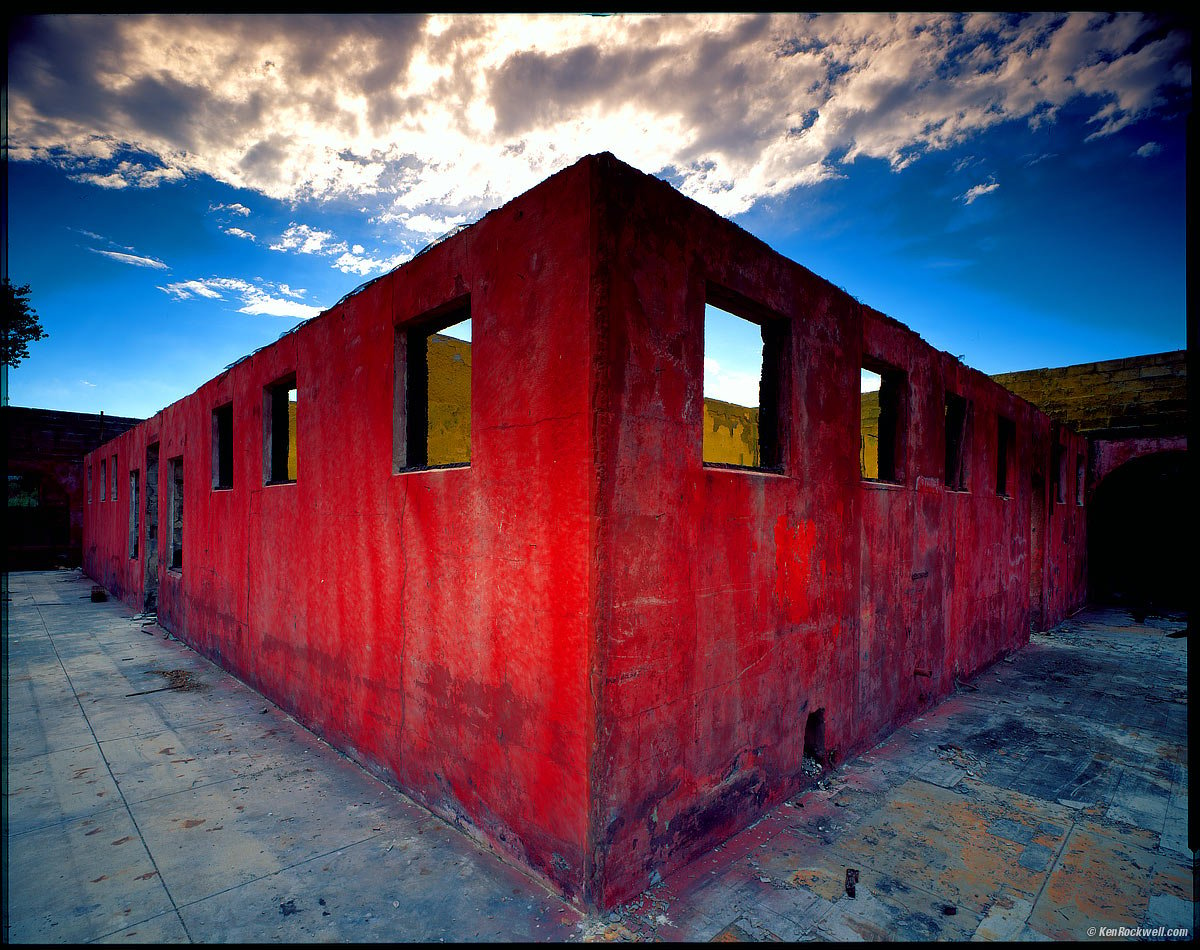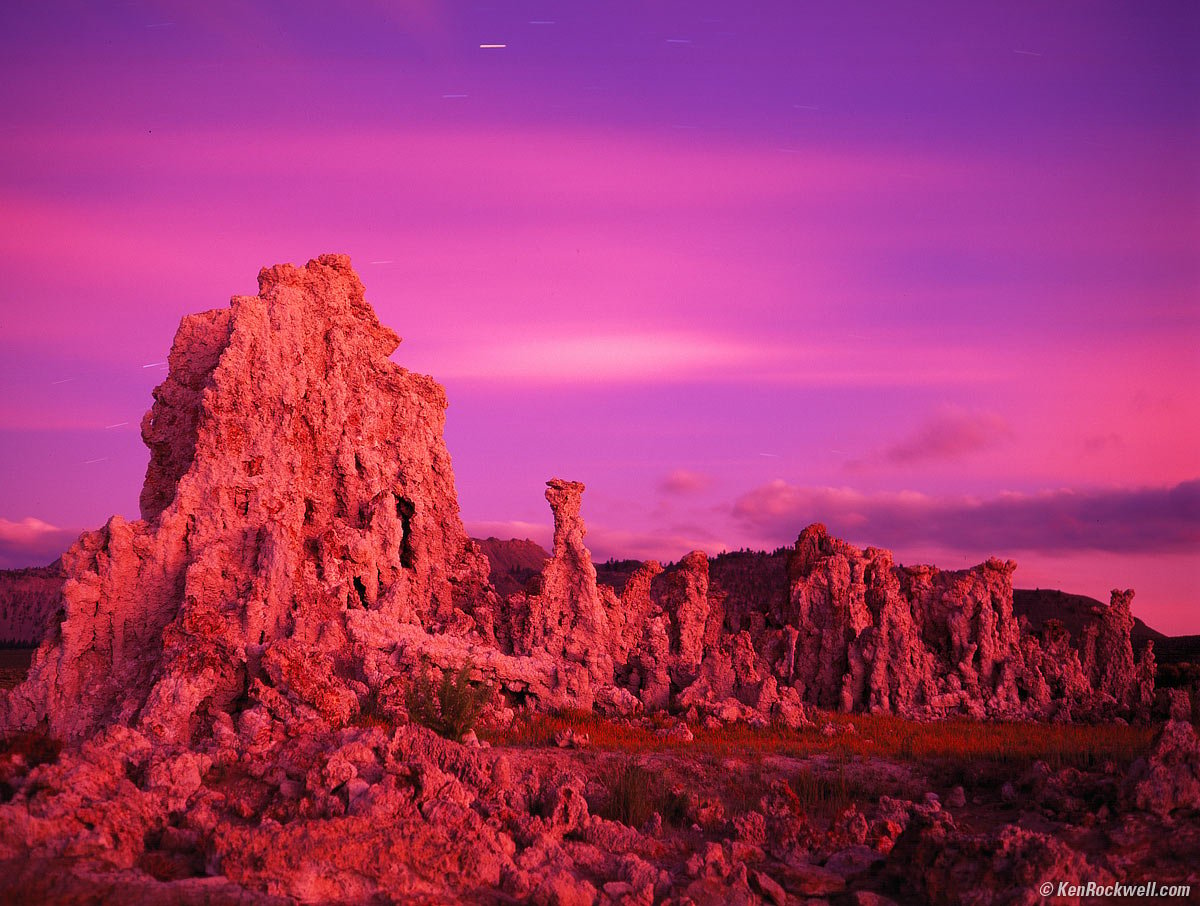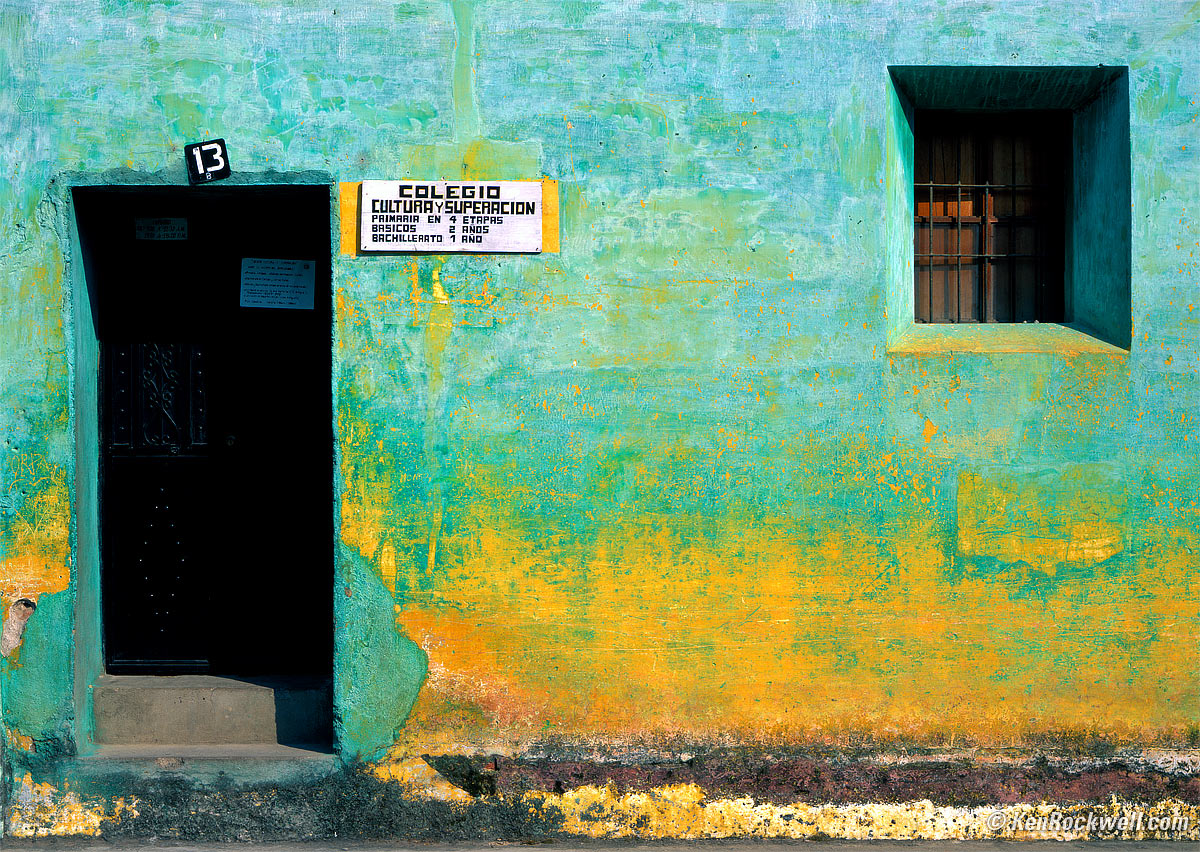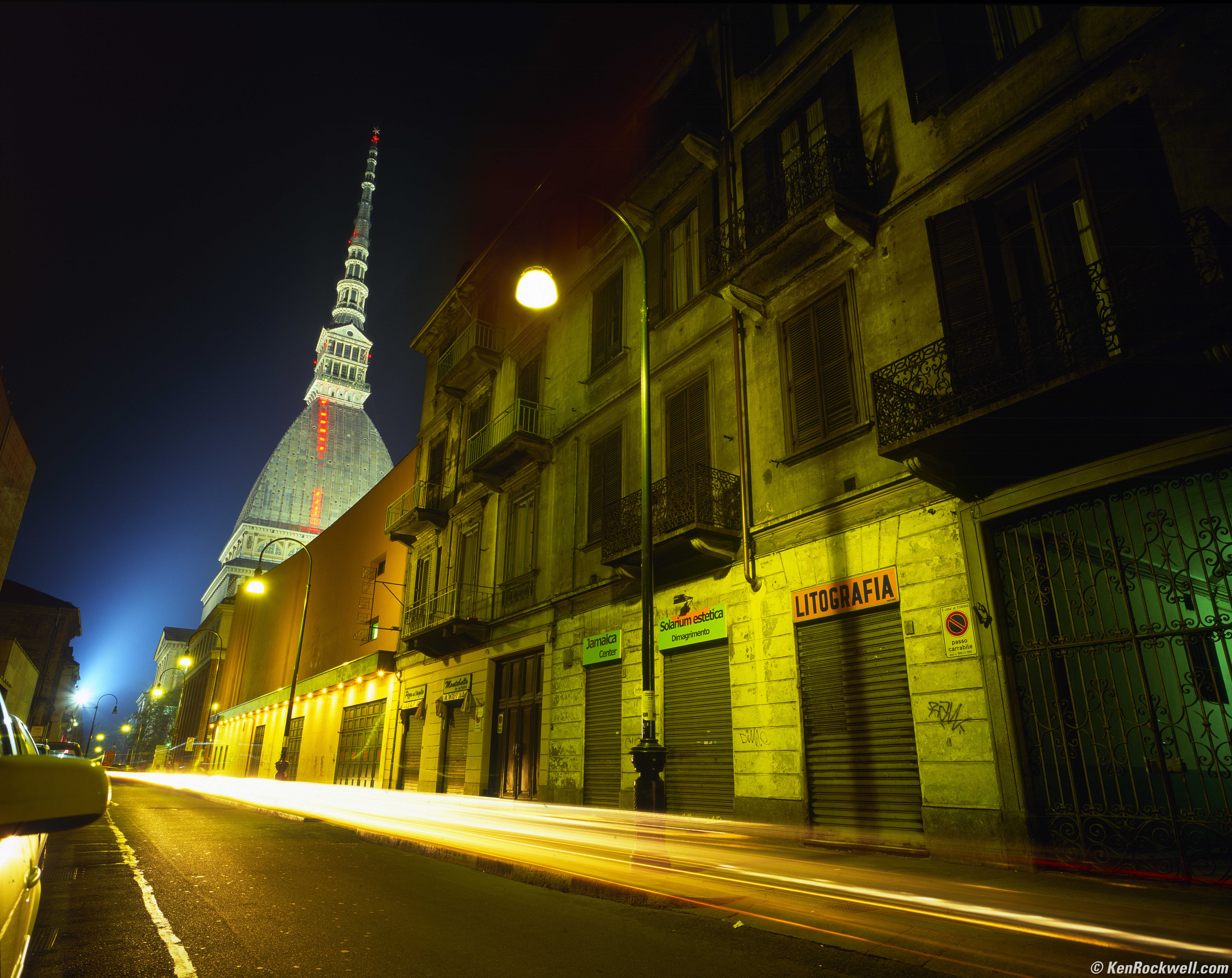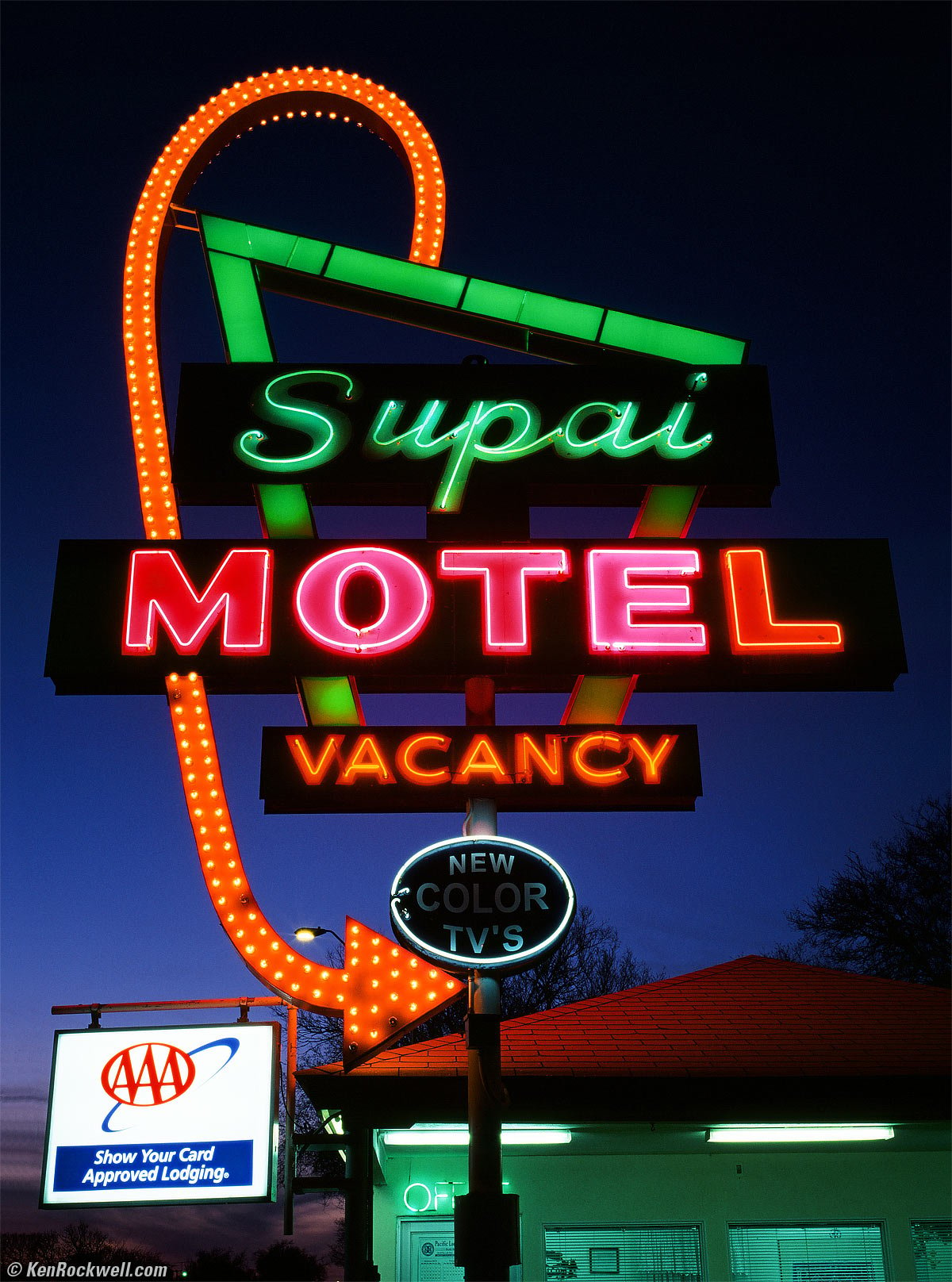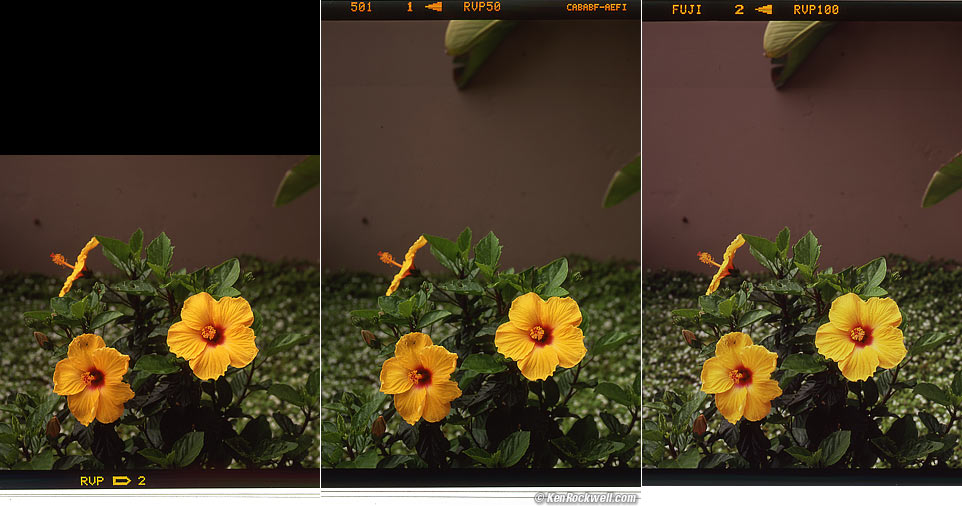Fuji Velvia 50
100-Speed Velvias More Comparisons
Ruin, San Diego County, 28 July, 1996. bigger. tech details.
April 2024 Better Pictures Fuji HASSELBLAD LEICA CONTAX Canon Nikon Zeiss Sony All Reviews
I've been buying my Velvia 50 to make these photos at Adorama and at B&H since 1990! You also can get it at Amazon.
This all-content, junk-free website's biggest source of support is when you use those or any of these links to approved sources when you get anything, regardless of the country in which you live. Thanks for helping me help you! Ken.
This is why I shoot Fuji Velvia 50:
Barstow, 2016. 1989 Hasselblad 903 SWC with B60 B+W F-DAY mild fluorescent filter, 2 meters focus distance (needed from 4.5' in focus), Fuji Velvia in 1996 Hasselblad E24 magazine, f/16 at 1 minute. bigger.
Mono Lake, California, 25 July 1993. bigger. tech details.
El Colegio, la Antigua, Guatemala, December, 1998. bigger. tech details.
Torino, Italy, October 2003. (10,000 x 8,000 pixels, shot with Mamiya 7 and Mamiya 43mm on 6x7cm.)
La Jolla as seen from Del Mar, 1992. (shot with Tachihara 4×5" camera, 210mm f/5.6 Nikkor-W, Fuji 4×5" Velvia.)
Zion National Park, October 2001. bigger. tech details.
Supai Motel, Seligman, Arizona, 16 February 2010. bigger. tech details.
|
Adorama pays top dollar for your used gear. I use these stores. I can't vouch for ads below.
|
My sample images are the review. If you like colors like these for subjects like these, this is why Fuji Velvia 50 has been the professional standard for nature and landscape photography since its introduction in 1990.
This is because Velvia 50 makes anything in sunlight look incredible. It makes warm colors warmer, while keeping everything else more vivid. It makes good dawn and afternoon light look even better than reality.
Velvia 50 makes people's faces too red; use Velvia 100 or anything else for people, but for everything else worth shooting in color, it's all about Velvia 50.
You like these colors? These are nothing compared to the way the film itself looks projected in a dark room. Velvia is a slide film; you stick it in a projector, and it looks unlike anything you've ever seen online or from a digital projector. These images are merely quick scans of the film; the film itself looks far better projected or on a light table.
I've been buying my Velvia 50 at Adorama and at B&H since 1990! You also can get it at Amazon.
Background
Velvia is the reason I am still a photographer. Most of what you see at my Gallery before 2012 was shot on it, not digital. My real photographer friends were still out backpacking with their Pentax 67s and Velvia back as recently as 2007, bringing digital cameras only as a joke. It's all about the look: Velvia simply makes landscapes and nature look the way we want it to.
I started at age 11 in 1973 shooting Kodachrome because it was such an elegant film, based only on technical specifications. My photos were boring, and I almost gave up on photography by the late 1980s.
In 1990 my TRW LSI colleague Mark Sauerwald suggested I try some of this new Japanese stuff called Velvia, whose colors were simply spectacular. No one trusted it back then, an old timers like another colleague Frank Brunner warned me about the old days (1950s) when people would try the latest, more vivid films instead of Kodachrome, and discover a year later that their Anscochromes or whatever were already faded away.
Since I also was moving from 35mm to 4×5" I needed to use a film available in 4×5," which was Velvia, since Kodachrome didn't come in 4×5.
I exposed my first frame of Velvia on July 9th, 1990, and was astounded. My slides now looked as vivid as I had always intended. Instead of amplifying atmospheric haze, Velvia ate right through it. Velvia amped up the colors to where they should be, not as they were.
Today my 20-year-old Velvia slides still look like the day the came back from the lab, which is a lot better than my Kodachromes have ever looked. Sorry Frank. I haven't put the film ends on a densitometer to measure just how identical they are, but I could.
I was hooked, and have shot nothing but Velvia from that point on. My work excited me and I kept at photography, instead of dropping it due to the disappointing green-cyan highlights and pinholes in my Kodachromes.
I've been buying my Velvia 50 at Adorama and at B&H since 1990! You also can get it at Amazon.
Sharpness and Brilliance
Velvia is sharper than any other film. For blind people, this is shown in the Fuji Velvia 50 Technical Data Sheet on the last page as the MTF Curve.
Velvia's MTF peaks at 120% at 10 cycles per millimeter. It is this 120% edge which gives Velvia 50 its greater "bite" than other slide films. Velvia 50 makes everything look sharper under the loupe.
Velvia is also the most brilliant film when seen on a light table or projected because it has the highest dynamic range of any other film: its dMax is darker than other slide films, giving your slides and images the greatest on-screen dynamic range when projected.
I've been buying my Velvia 50 at Adorama and at B&H since 1990! You also can get it at Amazon.
Nomenclature
Velvia was introduced in 1990, was always ISO 50, and was called simply "Velvia," edge code RVP.
Velvia was the last of Fuji's films that used an older type of clear plastic film, the "base," on which the layers were coated. All Fuji's films since 1990 have been on a different, newer, better base, while classic Velvia used the old one from the 1980s. For about 10 years between 1995 and 2005, Velvia had been the only film made on that obsolete plastic base.
Fuji couldn't justify making a film that demanded its own production line for an old, very difficult to manufacture base, and discontinued Velvia in 2005.
When Fuji heard the outcry for the original Velvia, they did the right thing and went back and redesigned the original coatings to work with the new base.
The new version is called Velvia 50, adding a "50" to differentiate it from traditional Velvia. Its edge code is RVP 50, while the code for the original is simply RVP.
The only thing that's changed with Velvia 50 is the plastic backing, not the coatings other than what modifications were needed to get them to stick to the different base.
The new boxes say "Velvia 50" in gold metallic ink, while the original boxes said "Velvia" in hot-stamped shiny gold foil.
Fuji's redesigned Velvia 50 is the most significant new product of the 2000 decade.
Thank you Fuji!
I've been buying my Velvia 50 at Adorama and at B&H since 1990! You also can get it at Amazon.
Weight
A 35mm, 36 exposure roll of Velvia 50 weighs 0.780 oz (22.1g).
In the plastic can, it weighs 0.9725 oz (27.6g).
A 36-exposure roll of Fuji Superia X-TRA 400 weighs 0.750 oz. (21.2g) in 2016.
100-speed Velvias top
In 2003 Fuji introduced Velvia 100F, a film improved in almost every technical way, but with somewhat less vivid color. The only thing that matters is color, so 100F never became popular for the landscape and nature photography for which Velvia has been the standard since 1990.
I met one of Velvia's original designers, who explained to me with great pride around 2003 that in Velvia 100F he finally had fixed one of the original technical defects of Velvia.
This defect was that Velvia adds red to warm colors. Yellows become slightly redder, oranges turn toward red and skin gets ruddy.
The only huge problem is that this defect is what gives Velvia its extraordinarily great look for landscapes and nature. We photographers are out freezing ourselves to death every sunrise hoping for the warmest first 60 seconds of sunlight to light up rocks against blue skies, and Velvia helps us by warming (improving) the golden sunshine. Velvia makes nature look better!
These Velvia 100s don't look anywhere near as good on a light table for the sorts of things I shoot on Velvia 50 as Velvia 50.
The ISO 50 versions are my favorites because I prefer their warmer yellows. Velvia makes skin too red, but makes yellows look wonderful. Velvia is for photographing things, not people. Velvia is not accurate — it makes landscapes look better than reality, which is why it's been the world standard for landscape and nature photography since 1990. Most of my Gallery is shot on Velvia.
Velvia 100 (RVP 100)
This is the good stuff the Japanese held back for themselves for a few years. It's as vivid as Velvia, faster, finer grained and much better for skin and long exposures.
Velvia 100 is better for skin because it doesn't turn warm colors redder as Velvia does, which is why Velvia 100 still doesn't look as good as Velvia for landscapes and still doesn't replace Velvia 50.
Velvia 100F (RVP 100F)
A duller and less warm version of Velvia 100.
More Comparisons top
This is all art, so everyone has their favorites, which is why there were more kinds of film than there are digital cameras.
Kodachrome: Green highlights, but was the pro standard for printing-press output. Proven long-term stability.
Velvia and Velvia 50: Today's standard for landscape and nature photography, ever since its introduction in 1990. Wild colors, ultra-sharp, makes warm light and colors even warmer, but makes people look sunburned.
Velvia 100: Less vivid than Velvia, doesn't help warm colors, but people look fine.
Velvia 100F: More faded colors than Velvia 100, but still snappy.
Provia 100 and 400X: Normal film for everything. Provia 400X is amazing: ISO 400 with not much more gain than slow films, but it will cost you.
Astia: Softer colors especially for people pictures. This is the portrait film.
Ektachrome: Yucky colors, too yellow-green in the highlights for me.
Usage top
I usually shoot it through an 81A (A2) filter at all times outdoors. In shade, I'll shoot through an 85C filter. See more at Filters and How to Shoot Film.
Velvia is very contrasty; you have to be careful. It pumps up what's dull, but if the image is already contrasty, you can be asking for trouble. Unli;ke with digital, you will never get all your shadow detail or all the highlights. As an artist you need to see what's important and expect to lose the rest — unless you're lighitng the set yourself.
Forget about polarizers. They were for Kodachrome; with Velvia 50, only use polarizers if you're trying to cut through excessive haze. Otherwise, on a nice day, using a polarizer with Velvia 50 can turn the skies way too dark.
Actual ISO
Velvia has much deeper blacks than most other slide film. This way it has much more depth and contrast when displayed against a black background or projected properly.
However, if all you do is look at it on a light table against white, it will look darker than regular slide film.
Therefore some people used to shoot it at ISO 40 to make it look brighter.
I shoot mine at ISO 50; of course everyone's meters vary.
Velvia 50 Reciprocity Failure Corrections
Film becomes less sensitive as exposure times become very long, so for minute-long exposures, we need to give more exposure than our light meters suggest.
It took me a while to calculate this in an easy-to-use form, and now it's easy to shoot in the dark.
All you do is take a meter reading, choose your aperture (I choose the sharpest aperture) and read the exposure time from your meter.
To find the actual exposure time to use, simply find the meter-indicated time in the left column, and use the actual exposure time in the right column.
For instance, if you want to shoot at f/11 and the meter says to use 15 seconds, use an actual exposure of 25 seconds at f/11. I don't worry about color shift or use color-compensating filters to correct for reciprocity failure; when I'm shooting long exposures I'm looking for crazy colors.
Don't worry about being exact, if you're within ±10% you're still perfect.
If meter reads |
Then use |
1 second |
1 second |
1.2 s |
1.2 s |
1.6 s |
2 s |
2 s |
2.5 s |
2.5 s |
3.2 s |
3.2 s |
4 s |
4 s |
5s |
5 s |
6.3s |
6.3 s |
10 s |
8 s |
12 s |
10 s |
15 s |
12 s |
20 s |
16 s |
25 s |
20 s |
32 s |
25 s |
45 s |
32 s |
1 m (64 s) |
40 s |
1.5 m (90s) |
50 s |
2 m (120 s) |
1 m (64 s) |
2.5 m (160s) |
1.2 m (80 s) |
3.5 m (220 s) |
1.6 m (100 s) |
5 m (300 s) |
2 m (128 s) |
6 m (400s) |
2.5 m (160 s) |
8 m (512s) |
3.2 m (200 s) |
10 m (640 s) |
4 m (256 s) |
13 m (800s) |
5 m (320 s) |
20 m (1,280 s) |
| 6.3 m (400 s) |
25 m (1,600 s) |
8 m (512 s) |
30 m (2,000s) |
Here's the even easier real-world way I use. I put a sticker on my meter with these two lines of numbers:
Read |
1s |
2s |
4s |
8s |
15s |
30s |
1m |
2m |
4m |
8m |
Use |
1s |
2.5s |
5s |
12s |
25s |
1m |
2.5m |
6m |
13m |
30m |
Digital Film Simulations top
Fuji's Film Simulations
Fuji’s digital-camera film simulations are AWFUL compared to real VELVIA film. They were made to make digital files that match poorly-made scans of VELVIA, rather than the actual look of film, so they look really bad to the practiced eye. Big goof on Fuji's part, but they didn’t ask me. They could have — and should — do much better to try to match the film itself, but they never have.
Nikon and Canon
I get much better results shooting digital by adjusting my Nikon or Canon image settings. Fuji’s digital-camera film simulations are dull and boring.
Neither Sony nor Fuji look like I want, but I can set my Nikon Picture Control to VIVID and then setting Saturation to +3, and on Canon I set Picture Style to STANDARD and then set Saturation to +4.
Recommendations top
You want these colors? Are you going to project directly from the original film onto a genuine and perfectly white screen (not a sheet or a wall) in a completely dark room, or enjoy it on a light table through a loupe? Shoot Velvia 50! I prefer LEICA projectors and projection lenses, which make Kodak Carousels look like they're broken by comparison.
If you're going to use the image digitally in any way, either for editing, viewing or printing, today in 2024 I greatly prefer the results I get shooting directly on Canon or Nikon digital to what I used to get with hours of pain visiting labs or scanning my film in olden days when I first wrote this page back in 2007. I set my camera as just mentioned at Film Simulations. Back in 2007 digital cameras were much worse than film in the hands of a virtuoso, but ever since 2013 or so they've been much better than film.
I haven't shot any 35mm VELVIA since 2013, or any format VELVIA since 2016. I sold almost all of my hundreds and hundreds and hundreds of rolls and sheets I had kept in deep freeze in my doomsday cache since 2004 to my pal Mike back in 2022 and doubt I'll ever shoot VELVIA again. It's too much work and I get better real-word results on digital. Good news is that my film that had expired 10 or 20 years before looks perfect; so long as it's been in deep freeze (-10º F) it doesn't seem to age at all. Then again, the last roll I shot in 2013 and left in a camera at room temperature had almost completely faded away by 2024 when I had it developed. Keep your Velvia frozen and develop promptly; don't leave the rest of the roll sitting around; just process it.
I've been buying my Velvia 50 at Adorama and at B&H since 1990! You also can get it at Amazon.
I use The Great American Photo Lab (formerly called North Coast Photo Services (NCPS)) for developing and scanning, and they do a lot of mail order from around the world.
More Information top
I've been buying my Velvia 50 at Adorama and at B&H since 1990! You also can get it at Amazon.
I use The Great American Photo Lab (formerly called North Coast Photo Services (NCPS)) for developing and scanning,
Fuji's Velvia 50 Technical Data Sheet.
© Ken Rockwell. All rights reserved. Tous droits réservés. Alle Rechte vorbehalten. Alla rättigheter förbehållna. Toate drepturile rezervate. Ken Rockwell® is a registered trademark.
Help Me Help You top
I support my growing family through this website, as crazy as it might seem.
The biggest help is when you use any of these links when you get anything. It costs you nothing, and is this site's, and thus my family's, biggest source of support. These places always have the best prices and service, which is why I've used them since before this website existed. I recommend them all personally.
If you find this page as helpful as a book you might have had to buy or a workshop you may have had to take, feel free to help me continue helping everyone.
If you've gotten your gear through one of my links or helped otherwise, you're family. It's great people like you who allow me to keep adding to this site full-time. Thanks!
If you haven't helped yet, please do, and consider helping me with a gift of $5.00.
As this page is copyrighted and formally registered, it is unlawful to make copies, especially in the form of printouts for personal use. If you wish to make a printout for personal use, you are granted one-time permission only if you PayPal me $5.00 per printout or part thereof. Thank you!
Thanks for reading!
Ken.
Irrelevant Technical Analysis
You want these colors? Shoot Velvia 50! The technical part isn't relevant.
Here's a crappy scan of three 120 format strips. I shot these in the same camera with different backs. I laid the three strips of film, still in their sleeves, on my Epson 4990 scanner to try to show what's the same and and what's different. (I've had Chrome process all my Velvia since 1990; they also do mail order.)
My biggest concern is warm yellows, my favorite color, which were uniquely rendered by traditional Velvia. Warm yellow means yellow with some red in it. A warm yellow hibiscus bloomed at my house, seen here under overcast light with an 81B glass filter to fix white balance.
This is a bad scan, but it shows what little it can to show you what I see on the light table: new Velvia 50's yellows match traditional Velvia. Other films, like Velvia 100 below, render yellows too coolly, even if they may be more accurate.
Velvia, Velvia 50 and Velvia 100 Compared. bigger.
(Made with my Horseman SW-612P interchangeable-back, medium format panoramic camera and 90mm f/6.8 Rodenstock Grandagon, 81B filter, f/8 @ 1/30 [f/11 for Velvia 100] in windy, overcast conditions. Sorry that since I first published this as a vertical composite that I whacked off the top of the Velvia RVP strip, now filled in black above in this sideways triptych.)
On the light table, the new and old Velvias have the same warm yellow, while Velvia 100 has a cooler yellow. The warmer yellow is why I love traditional Velvia. The old and new Velvia 50 seem identical, within the limits of my ability to swap out magazines as clouds blew around. My original Velvia is past-dated, and it tends to go magenta with age. I think I'm seeing a little bit of that here - on my light table what doesn't match is more magenta cast in my old Velvia. I remember 1990 when Velvia first came out: it tended towards green until Fuji really dialed it in.
Don't spend any more time trying to analyze these images above other than to note that the warm yellows match, and that Velvia 100 is cooler. If you look too hard; you'll be seeing artifacts of my scanning, not what's really on the film in front of me.
dMax
dMax also looks identical on my first test rolls. New Velvia 50 has the same inky, vivid blacks as traditional Velvia. This makes it pop on a light table and projected, and also makes it better than many consumer scanners. Velvia 100 has a weaker (less dark) dMax than either of Velvia or Velvia 50.
Home Donate New Search Gallery Reviews How-To Books Links Workshops About Contact
